Abdulmejid II
Abdulmejid II (Ottoman Turkish: عبد المجید ثانی, romanized: ʿAbdü'l-Mecîd-i sânî; Turkish: II. Abdülmecid;[5][6] 29 May 1868 – 23 August 1944) was the last Ottoman caliph, the only caliph of the Republic of Turkey, and head of the Osmanoğlu family from 1926 to 1944. As opposed to previous caliphs, he used the title Halîfe-i Müslimîn (Caliph of the Muslims), instead of Emîrü'l-Mü'minîn (Commander of the Faithful).[1]
| Abdulmejid II | |||||
|---|---|---|---|---|---|
 Official portrait of Caliph Abdulmejid II | |||||
| Ottoman caliph (Halîfe-i Müslimîn)[1] | |||||
| Tenure | 19 November 1922 – 3 March 1924 | ||||
| Predecessor | Mehmed VI | ||||
| Successor | Caliphate abolished | ||||
| Head of the Osmanoğlu family | |||||
| Reign | 16 May 1926 – 23 August 1944 | ||||
| Predecessor | Mehmed VI | ||||
| Successor | Ahmed Nihad | ||||
| Born | 29/30 May 1868[2][3] Beşiktaş, Istanbul, Ottoman Empire | ||||
| Died | 23 August 1944 (aged 76) Paris, France, Nazi Germany | ||||
| Burial | |||||
| Consorts | |||||
| Issue | |||||
| |||||
| Dynasty | Ottoman | ||||
| Father | Abdulaziz | ||||
| Mother | Hayranidil Kadın | ||||
| Religion | Sunni Islam | ||||
Biography
Early years
On 30 May 1868,[2][3] he was born at Dolmabahçe Palace, Beşiktaş, Istanbul, to then Sultan Abdulaziz and his consort Hayranidil Kadın. He was the younger full brother of Nazime Sultan. He was educated privately.
In accordance with late Ottoman custom, Abdulmejid was confined to the palace until he was 40. On 4 July 1918, his first cousin Mehmed VI became Sultan and Abdulmejid was named Crown Prince.[2] When his cousin was deposed on 1 November 1922, the Ottoman Sultanate was abolished. But on 19 November 1922, the Crown Prince was elected Caliph by the Turkish National Assembly at Ankara.[2] He established himself in Istanbul[7][8] on 24 November 1922.
On 3 March 1924, six months after the foundation of the Turkish Republic, the Ottoman Caliphate was abolished and the Ottoman dynasty was deposed and expelled from Turkey.[9][10]
 Abdulmejid II
Abdulmejid II Portrait of Abdulmejid II in Topkapı Palace Museum
Portrait of Abdulmejid II in Topkapı Palace Museum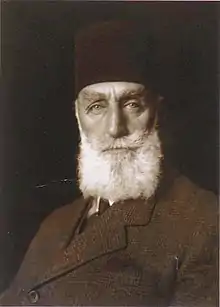 Abdulmejid II
Abdulmejid II Top: The Chief Eunuch of the Caliph
Top: The Chief Eunuch of the Caliph
Bottom: The Caliph enters his Royal Barge.tif.jpg.webp) The Caliph walking with entourage of soldiers, officials and a brass band as women watch
The Caliph walking with entourage of soldiers, officials and a brass band as women watch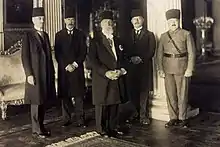 The Caliph being officially informed of his dethronement
The Caliph being officially informed of his dethronement
As artist
Abdulmejid was given the title of General in the Ottoman Army, but did not have strong military inclinations. He had a more significant role as Chairman of the Ottoman Artists' Society.
He is considered one of the most important painters of late period Ottoman art. His paintings of the Harem, showing a modern musical gathering, and of his wife, Şehsuvar Hanım, reading Goethe's novel Faust, express the influence of western Europe in his elite circle.[11] These were displayed at a 1918 exhibition of Ottoman paintings in Vienna. His personal self-portrait can be seen at Istanbul Modern.
Abdulmejid was also an avid collector of butterflies, an activity that he pursued during the last 20 years of his life. His favourite magazine was Revue des deux Mondes.[11]
Paintings
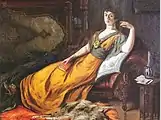 Haremde Goethe, 1898/1917, State Art and Sculpture Museum
Haremde Goethe, 1898/1917, State Art and Sculpture Museum Haremde Beethoven, 1915, İstanbul State Art and Sculpture Museum
Haremde Beethoven, 1915, İstanbul State Art and Sculpture Museum Cami Kapısı, 1920, Sakıp Sabancı Museum
Cami Kapısı, 1920, Sakıp Sabancı Museum Painting of Abdülhak Hamit Tarhan, with the text in Ottoman Turkish saying, "made with the heart".
Painting of Abdülhak Hamit Tarhan, with the text in Ottoman Turkish saying, "made with the heart".
Personal life
Abdülmecid's first wife was Şehsuvar Hanım, a Turk[4] or an Ubykh. They married on 23 December 1896. She was the mother of Şehzade Ömer Faruk,[12] born in 1898.[13] She died in Paris in 1945,[12] and was buried in Bobigny cemetery. His second wife was Mihrimah Hanım. She died at the Nakkaştepe Palace, on 23 May 1899, and was buried in Nuhkuyusu Mosque, Istanbul.[14][15]
His third wife[4] was Hayrünissa Hanım,[16] a Circassian.[4] She was childless.[16][17] His fourth wife was Mehisti Hanım. She was a Circassian-Abkhazian. Her father was Akalsba Hacımaf Bey, and her mother was Safiye Hanım. They married on 16 April 1912.[14] She was the mother of Dürrüşehvar Sultan (who married Azam Jah, son of Mir Osman Ali Khan), born in 1914.[18] She died in Middlesex, London in 1964, and was buried in Brookwood cemetery.[19]
 Abdulmejid II with his daughter Dürrüşehvar and fourth wife Mehisti Hanım
Abdulmejid II with his daughter Dürrüşehvar and fourth wife Mehisti Hanım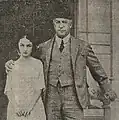 Abdulmejid II and Dürrüşehvar
Abdulmejid II and Dürrüşehvar
Life in exile and death
The caliph was nominally the supreme religious and political leader of all Muslims across the world, with the main goal to prevent extremism or protect the religion from corruption.[20] In the last session of the budget negotiations on 3 March 1924, Urfa Deputy Sheikh Saffet Efendi and his 53 friends demanded the abolition of the caliphate, arguing it was not necessary anymore. This was approved by majority of the votes and a law was established. With the same law, it was decided to expel all members of the Ottoman dynasty. Mustafa Kemal Atatürk, however, offered the caliphate to Ahmed Sharif as-Senussi, on the condition that he reside outside Turkey; Senussi declined the offer and confirmed his support for Abdulmejid.[21]
Although Abdülmecid and his family were upset about this decision, they did not want the people to revolt, so they secretly went to Çatalca by car from the Dolmabahçe Palace at 5:00 the next morning. Here, after being hosted by the head of the Rumeli Railways Company for a while, they were put on the Simplon Express.[22]
When Abdulmejid II arrived in Switzerland, he was detained at the border for a while, but was admitted to the country after a delay.[23] In Switzerland, he said multiple times that he was upset about the abolition of the caliphate, and that this would bring chaos to the Islamic world, with the rise of extremism. But after the Turkish government put pressure on the Swiss government, Abdulmejid was never allowed to give such speeches in Switzerland again.[24] After staying in Switzerland for a while, he moved to Nice, France in October 1924.[25][6]
Abdulmejid lived a quiet life in Nice, France.[26] At first he was poor, hungry, and almost homeless. His daughter Dürrüşehvar Sultan and his niece Nilüfer Hanım Sultan married the sons of the Nizam of Hyderabad, one of the richest people in the world; thanks to this, his financial situation improved. As he didn't get the anticipated support from the Islamic world for the restoration of the caliphate, he started to focus more on worship, painting, and music.[26]
Abdulmejid, who later settled in Paris, used to perform Friday prayers at the Grand Mosque of Paris with other Muslims in the region. After the departure of his very fond grandchildren and son, who left France to marry the Kavala princes of Egypt, he spent painful days alone. He wrote a 12-volume book of memoirs, preserved by his daughter Dürrüşehvar Sultan.
On 23 August 1944, Abdulmejid II died at his house in the 15th Avenue du Maréchal Mounoury, Paris, due to a heart attack.[27] His death coincided with the Liberation of Paris from the German occupation. Despite the efforts of Dürrüşehvar Sultan, the Turkish government did not permit his funeral to be held in Turkey. Subsequently, his remains were preserved at the Grand Mosque of Paris for ten years. Finally, when the mosque could no longer maintain his body, his remains were transferred to Medina where he was buried in the special Al-Baqi' cemetery due to him being a caliph.
 Abdulmejid II and Dürrüşehvar in Promenade des Anglais, Nice, France
Abdulmejid II and Dürrüşehvar in Promenade des Anglais, Nice, France Princess Dürrüşehvar Sultan, Princess of Berar; Caliph Abdulmejid II of the Ottoman dynasty, and Nawab Azam Jah, Prince of Berar, 1931
Princess Dürrüşehvar Sultan, Princess of Berar; Caliph Abdulmejid II of the Ottoman dynasty, and Nawab Azam Jah, Prince of Berar, 1931
Honours and arms
Ottoman honours
- Order of House of Osman, Jeweled[28][29]
- Order of Glory, Jeweled[28][29]
- Imtiyaz Medal, Jeweled[28][29]
- Order of Osmanieh, Jeweled[28][29]
- Order of the Medjidie, Jeweled[28][29]
- Iftikhar Sanayi Medal[28][29]
- Imtiyaz War Medal in Gold[29]
- Outstanding Navy Medal in Gold[29]
Foreign honours
.svg.png.webp) Austria-Hungary: Grand-Cross Order of Leopold, 6 June 1918[30]
Austria-Hungary: Grand-Cross Order of Leopold, 6 June 1918[30].svg.png.webp) Persia: Order of the Crown, 2nd Class, 23 August 1919[31]
Persia: Order of the Crown, 2nd Class, 23 August 1919[31]
Arms
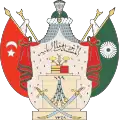 Coat of Arms of the Caliph
Coat of Arms of the Caliph
Family
Consorts
Abdülmejid II had four consorts:[32][33][13]
- Şehsuvar Kadın (2 May 1881-1945). They married on 22 December 1896 and had a son.
- Hayrünnisa Kadın (2 March 1876-3 September 1936). She was born in Bandirma, Turkey. They married on 18 June 1902 in Ortakoy Palace. She died in Nice. Hayrünisa was extremely well educated and a cello virtuoso. She was portrayed by her husband while playing.
- Mihrimah Bihruz Kadın (24 May 1893-1955). She was born in İzmit. They married on 21 March 1912 in Çamlıca Palace. She died in Istanbul.
- Atiye Mehisti Kadın (27 January 1892-1964). She was born in Adapadari. They married on 16 April 1912 in Bağlarbaşı Palace and had a daughter. She died in London.
Issue
Abdülmejid II had a son and a daughter:[32][34][18]
- Şehzade Ömer Faruk (27 February 1898 - 28 March 1969) - with Şehsuvar Kadın. Married twice with two his cousins and had three daughters by his first marriage.
- Hatice Hayriye Ayşe Dürrüşehvar Sultan (26 January 1914 - 7 February 2006) - with Mehisti Kadın. She married an Indian prince and had two sons.
References
- "Abdülmecid Efendi". TDV Encyclopedia of Islam (44+2 vols.) (in Turkish). Istanbul: Turkiye Diyanet Foundation, Centre for Islamic Studies. 1988–2016.
- Hoiberg, Dale H., ed. (2010). "Abdümecid II". Encyclopædia Britannica. Vol. I: A-ak Bayes (15th ed.). Chicago, Illinois: Encyclopædia Britannica Inc. pp. 23. ISBN 978-1-59339-837-8.
- There are sources that give the 29th as the day of his birth.
- Moralı, Seniha Sami (1978). Meşrutiyet, Dolmabahçe Sarayı ve Ankara'nın İlk Günlerine Dair. p. 60.
- "II. Abdülmecid kimdir?". www.biyografi.info (in Turkish). Retrieved 23 March 2021.
- Keramet., Nigar, Salih (1964). Halife II. Abdülmecid : yurdundan nasıl sürüldü, sonra nerelerde yaşadı, ne zaman ve nerede öldü, ne zaman ve nerede gömüldü. İnkılap ve Aka Kitabevleri. OCLC 984425856.
{{cite book}}: CS1 maint: multiple names: authors list (link) - The Encyclopædia Britannica, Vol.7, Edited by Hugh Chisholm, (1911), 3; Constantinople, the capital of the Ottoman Empire...
- Britannica Concise Encyclopedia. Encyclopaedia Britannica, Inc. 1 May 2008. p. 966. ISBN 9781593394929.
- Finkel, Caroline (2007). Osman's Dream: The History of the Ottoman Empire. Basic Books. p. 546. ISBN 9780465008506.
- Özoğlu 2011, p. 5.
- "The Ottoman caliphate: Worldly, pluralist, hedonistic—and Muslim, too". The Economist. 19 December 2015. Retrieved 26 December 2015.
- Uçan 2019, pp. 256–257.
- Uçan 2019, p. 261.
- Uçan 2019, p. 258.
- Haskan, Mehmet Nermi (2001). Yüzyıllar boyunca Üsküdar – Volume 1. Üsküdar Belediyesi. p. 298. ISBN 978-9-759-76062-5.
- Uçan 2019, p. 259.
- Bardakçı, Murat (2017). Neslishah: The Last Ottoman Princess. Oxford University Press. p. 110. ISBN 978-9-774-16837-6.
- Uçan 2019, p. 267.
- Sakaoğlu, Necdet (2008). Bu Mülkün Kadın Sultanları: Vâlide Sultanlar, Hâtunlar, Hasekiler, Kandınefendiler, Sultanefendiler. Oğlak Yayıncılık. p. 713. ISBN 978-6-051-71079-2.
- Özcan 1997, pp. 45–52.
- Özoğlu 2011, p. 5; Özoğlu quotes 867.00/1801: Mark Lambert Bristol on 19 August 1924.
- Yücel, İdris. "İdris Yücel, Fransız Belgelerinde Son Halife Abdülmecid ve Türkiye'de Hilafetin Kaldırılması, Atatürk Yolu Dergisi, Sayı 61, Güz 2017". Archived from the original on 4 February 2019. Retrieved 18 January 2019.
- Lord Kinross, The Rebirth of a Nation, Kasım 1966, Sayfa 386, Amerikan Neşriyatı Bürosu için özel basım (ISBN bilgisi yoktur).
- "Ayşe Hür, Evvel Zaman İçinde Halifelik Vardı, Taraf gazetesi, 07.03.2010". 7 March 2010. Archived from the original on 21 September 2013. Retrieved 20 January 2020.
- "Cengiz Özakıncı, Haremde Beethoven, Sarayda Goethe: Son Halife Abdülmecid Efendi, Bütün Dünya dergisi, Şubat 2011" (PDF). Archived from the original (PDF) on 23 September 2015. Retrieved 5 March 2015.
- "Cevdet Küçük, Abdülmecid Efendi, Türk Diyanet Vakfı İslam Ansiklopedisi" (PDF). Archived from the original (PDF) on 2 April 2015. Retrieved 6 March 2015.
- Uçan, Lale. "Son Halife Abdülmecid Efendi'nin Hayatı- Şehzâdelik, Veliahtlık ve Halifelik Yılları" (PDF). İstanbul Üniversitsi Sosyal Bilimler Enstitüsü doktora tezi, İstanbul 2019. Archived from the original (PDF) on 27 November 2020. Retrieved 27 January 2021.
- Yılmaz Öztuna (1978). Başlangıcından zamanımıza kadar büyük Türkiye tarihi: Türkiye'nin siyasî, medenî, kültür, teşkilât ve san'at tarihi. Ötüken Yayınevi. p. 164.
- Alp, Ruhat (2018). Osmanlı Devleti'nde Veliahtlık Kurumu (1908–1922). p. 324.
- Uçan 2019, p. 59.
- Uçan 2019, p. 83–84.
- Adra, Jamil (2005). Genealogy of the Imperial Ottoman Family 2005. pp. 37–38.
- Bardakçı 2017, p. xvi.
- Bardakçı 2017, p. xiv.
Bibliography
- Özcan, Azmi (1997). Pan-Islamism: Indian Muslims, the Ottomans and Britain, 1877–1924. BRILL. ISBN 90-04-10632-4.
- Özoğlu, Hakan (2011). From Caliphate to Secular State: Power Struggle in the Early Turkish Republic. ABC-CLIO. ISBN 9780313379567.
- Uçan, Lâle (2019). Son Halife Abdülmecid Efendi'nin Hayatı - Şehzâlik, Veliahtlık ve Halifelik Yılları (PDF) (PhD Thesis). Istanbul University Institute of Social Sciences.

.svg.png.webp)